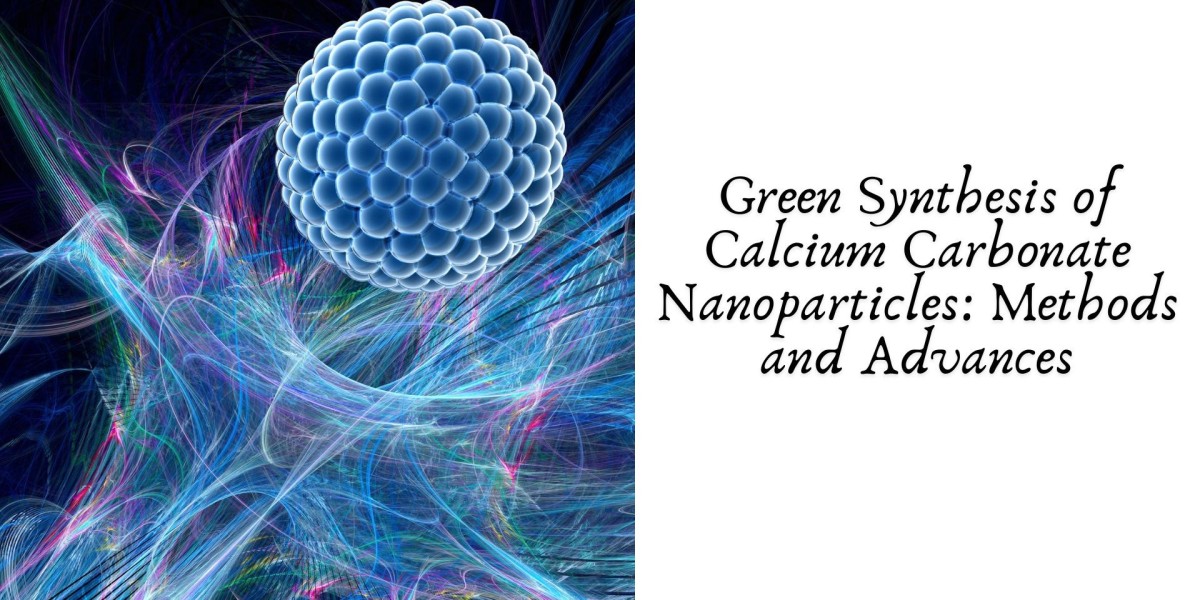Calcium carbonate nanoparticles have garnered significant attention in recent years due to their wide-ranging applications in various industries, including medicine, agriculture, and materials science. These nanoparticles are prized for their biocompatibility, non-toxic nature, and impressive surface reactivity. Among the different methods for synthesizing calcium carbonate nanoparticles, green synthesis has emerged as an environmentally friendly and sustainable approach. This article delves into the methods, recent advances, and the importance of green synthesis for producing calcium carbonate nanoparticles.
The Importance of Green Synthesis
Traditional methods for synthesizing calcium carbonate nanoparticles often involve chemical routes that require high energy, expensive reagents, and generate considerable waste. In contrast, green synthesis offers a sustainable alternative that minimizes environmental impact by using natural resources and renewable agents.
Green synthesis refers to the use of eco-friendly raw materials, such as plant extracts, microorganisms, or biodegradable compounds, to produce nanoparticles. These natural sources contain phytochemicals and other bioactive compounds that can act as reducing and stabilizing agents, making the process simpler, safer, and less toxic.
Methods of Green Synthesis of Calcium Carbonate Nanoparticles
Plant Extract-Mediated Synthesis
One of the most popular methods of green synthesis involves the use of plant extracts. Various parts of plants, such as leaves, stems, and roots, can be used to extract phytochemicals that aid in nanoparticle formation. The plant extracts are mixed with calcium salts, such as calcium chloride, in a solution. The bioactive compounds present in the extracts initiate the formation of calcium carbonate nanoparticles.
For instance, green tea, aloe vera, and mint are commonly used in this method. The compounds such as polyphenols, flavonoids, and proteins present in these extracts act as natural stabilizers and nucleating agents, preventing agglomeration and enhancing the uniformity of nanoparticles.
Microbial Synthesis
Another promising method involves the use of microorganisms like bacteria, fungi, and algae to produce calcium carbonate nanoparticles. Microorganisms have evolved mechanisms to uptake metal ions and convert them into less toxic mineral forms. Certain bacteria, such as Bacillus subtilis, can facilitate biomineralization, where calcium carbonate is synthesized via metabolic processes.
Fungi are also used for nanoparticle production, as they can secrete large amounts of extracellular enzymes that facilitate the nucleation and growth of calcium carbonate nanoparticles. The microbial method is cost-effective and sustainable, as it can utilize biomass waste and can be performed at ambient temperatures and pressures.
Biomimetic Synthesis
Biomimetic synthesis draws inspiration from biological processes that occur in nature, such as the formation of shells in marine organisms or the skeletal structure of corals. These natural processes involve the controlled crystallization of calcium carbonate, resulting in highly ordered structures.
Biomimetic methods aim to replicate these processes in the lab by using biomolecules, such as polysaccharides, proteins, and other organic matrices, to mediate the synthesis of nanoparticles. This approach allows for greater control over the particle size, morphology, and crystallinity of calcium carbonate nanoparticles, while still maintaining a green, environmentally friendly process.
Recent Advances in Green Synthesis
The development of green synthesis techniques for calcium carbonate nanoparticles has seen significant advancements, especially in terms of scalability, customization, and enhanced properties. Recent studies have focused on improving the functional properties of nanoparticles, such as stability, surface area, and biocompatibility.
Functionalized Calcium Carbonate Nanoparticles
Researchers have been exploring the functionalization of calcium carbonate nanoparticles to improve their suitability for specific applications. For example, functionalizing the surface of nanoparticles with organic molecules or polymers can enhance their performance as drug carriers in the biomedical field. Green synthesis methods involving plant extracts have been found to impart functional groups onto the nanoparticle surface, aiding in targeted drug delivery.
Use of Agricultural Waste
To make the process more sustainable, researchers have started to use agricultural waste materials, such as fruit peels or leaves, as a source of calcium and reducing agents. These waste materials are rich in organic compounds that facilitate the formation of nanoparticles while reducing the need for synthetic chemicals. This approach not only helps produce calcium carbonate nanoparticles but also reduces the burden of agricultural waste disposal.
Enhanced Morphological Control
One of the challenges in nanoparticle synthesis is controlling the size and shape of the nanoparticles. Advances in green synthesis have led to improved techniques for controlling the morphology of calcium carbonate nanoparticles, which is crucial for their application in specific fields. By fine-tuning the concentration of plant extracts, pH of the solution, and reaction temperature, researchers have been able to produce nanoparticles with precise size distributions and desired crystal structures, such as calcite, aragonite, or vaterite.
Applications of Green Synthesized Calcium Carbonate Nanoparticles
The use of green-synthesized calcium carbonate nanoparticles spans several sectors, owing to their unique properties and environmental compatibility:
Biomedical Applications
Calcium carbonate nanoparticles are used in drug delivery systems due to their biocompatibility and ease of biodegradation. Green synthesis imparts biocompatible surface properties that make these nanoparticles suitable for carrying drugs, especially for cancer treatment, where targeted delivery is crucial. Furthermore, calcium carbonate nanoparticles have been explored as vehicles for delivering genes and enzymes due to their ability to dissolve under slightly acidic conditions, such as those found in tumors.
Agricultural Sector
Green-synthesized calcium carbonate nanoparticles have found applications in the agricultural sector as a soil conditioner and as a means to deliver micronutrients to plants. The controlled release of calcium ions from these nanoparticles can help correct calcium deficiencies in plants, promoting better crop yield and growth.
Environmental Applications
Calcium carbonate nanoparticles are also used in environmental remediation, particularly for water treatment. The green synthesis process minimizes the risk of introducing toxic substances during the treatment process, making these nanoparticles ideal for removing pollutants such as heavy metals from water.
Challenges and Future Directions
Despite the significant advancements in the green synthesis of calcium carbonate nanoparticles, several challenges remain. The variability in plant extracts and microbial cultures can lead to inconsistencies in the size and shape of nanoparticles, making standardization a major hurdle for industrial applications. Furthermore, scaling up green synthesis methods while maintaining cost-effectiveness and uniform quality is an ongoing challenge.
Future research will likely focus on optimizing the green synthesis process for greater reproducibility and control over nanoparticle properties. Additionally, developing hybrid methods that combine different green synthesis approaches could provide a more versatile and reliable route for producing high-quality calcium carbonate nanoparticles. Further exploration into using different biological sources, such as marine algae, could also expand the range of functional nanoparticles available for various applications.
Conclusion
The green synthesis of calcium carbonate nanoparticles presents a sustainable and environmentally friendly alternative to traditional chemical synthesis methods. By leveraging plant extracts, microorganisms, and biomimetic principles, researchers have been able to produce calcium carbonate nanoparticles with desirable properties suitable for a wide range of applications. Advances in functionalization, agricultural waste utilization, and morphological control have further expanded the potential of these nanoparticles. While challenges in standardization and scalability remain, the future of green synthesis for calcium carbonate nanoparticles looks promising, offering innovative solutions to meet the growing demand for environmentally conscious nanomaterials.








